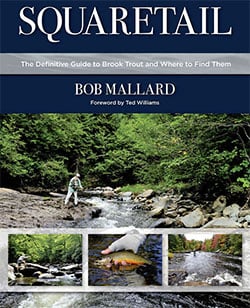Fly Rods for Brook Trout

No species of trout can be found in more varied habitats than brook trout. They inhabit streams, rivers, ponds, lakes, estuaries, and bays. They live in streams narrow enough to step across, rivers wide enough to require several double-hauls to cast across, and lakes so big they can only be fished from a large motorboat.
Brook trout vary in size more than most trout as well, running from less than 4 inches to over 20 inches, and from well under a pound to close to 10 pounds. As opportunistic feeders, brook trout feed on everything from tiny midge larvae to giant hellgrammite nymphs, minute Blue Winged Olives (BWOs) to bulky stoneflies, inch-long dace to inches-long sculpin, and leeches, crayfish, and even mice.
Because of all these factors, the tackle and techniques best suited to pursuing brook trout vary radically depending on where you live, the type of water you fish, and to some degree the size of the fish you expect to encounter. At the component level, brook trout anglers use pretty much the same tackle all other fly fishers use. Like other anglers they are likely to have more than one rod and reel, several lines, something to wade in, a net or two, a couple of vests or packs, maybe a watercraft or two, an assortment of tools and chemicals, and myriad flies.
What makes brook trout anglers somewhat unique, however, is the fact that the range of tackle at the component level is greater for brook trout than for many other species. This is due to the broad range of fish sizes that brook trout anglers encounter, as well as the various types of water they fish. What works on a tiny mountain stream does not work on a lake or pond—at least not well.
There is no real length and line-weight range for brook trout fishing. A range of 6-to 10-foot and 2-to 7-weight, which is accurate, would be of no value, as it represents a huge percentage of the rods sold today. Add slow-action to fast-action, and glass to graphite, and it is even more
vague. And if you are a backcountry angler, multi-piece rods of more than four pieces can be a good idea.
While rivers can be fished with conventional “trout” rods, small brook trout streams require specialty products to effectively fish them. And lakes and ponds present unique challenges as well, and this varies depending on the type of watercraft you are using.
Small freestone streams present a challenge to fly fishers. Tight quarters, low canopy, and short casts are the rule, making rods in the 5-to 7.5-foot range a good choice. Due to the short casts and small fish, slow-action rods, including glass and bamboo, work best. For the same reasons, rods in the 2-to 3-weight range are your best bet. Tenkara rods have made inroads with small-stream anglers over the last decade. While relatively new to the United States, Tenkara fishing has been around for a couple of centuries in Japan. These simple telescopic rods are used without a reel, and the fly is more dropped than cast. At lengths up to 12 feet, you can reach fish that would be tough to reach with a traditional fly rod. While Lefty Kreh once referred to Tenkara as a “fad” and said it wouldn’t last, the jury is still out.
For large streams and small rivers, I prefer an 8-foot, 4-weight medium-action rod, as it gives me a bit more length and distance without overwhelming what are often small fish. If you fish large rivers, a standard 9-foot, 5-weight, all-purpose, medium-action “trout rod” will suffice. If you like throwing streamers, you may want to consider a 6-weight. If you nymph a lot, you may want a longer rod in the 10- to 11-foot range.
If you fish lakes and ponds, a standard 9-foot, 5-weight fast-action rod is the best all-around option. If you fish from a personal watercraft, consider a 10-foot, 5-weight rod, as the longer length helps lift line off the water and keep your backcast out of the water. And if you do a lot of wet-lining in lakes and ponds, a 6-weight can be a great option.
Anglers fishing mice and big streamers for large brook trout in Canada, Patagonia, and parts of the United States often use 7-weights.
Excerpted from Squaretail: The Definitive Guide to Brooktrout and Where to Find Them (Stackpole Books, 2019); reprinted with permission. All rights reserved. The content has been streamlined for online publication. You can purchase signed copies of Bob’s book at www.bobmallard.com/shop.












